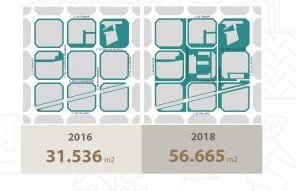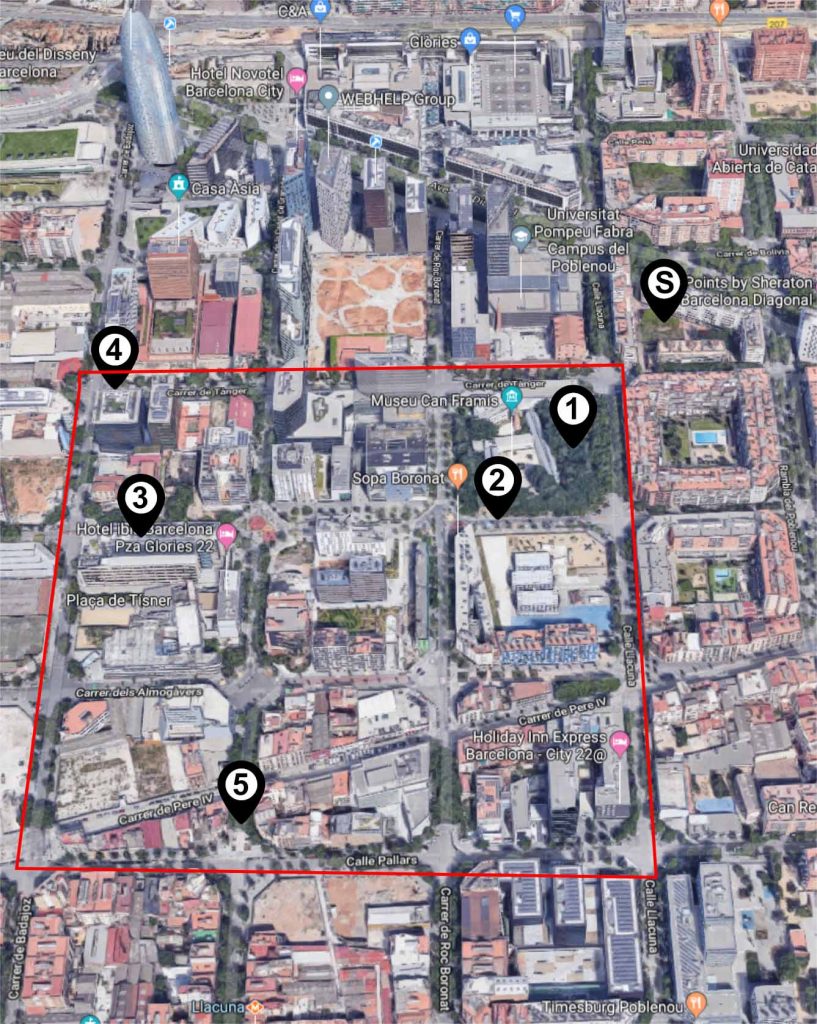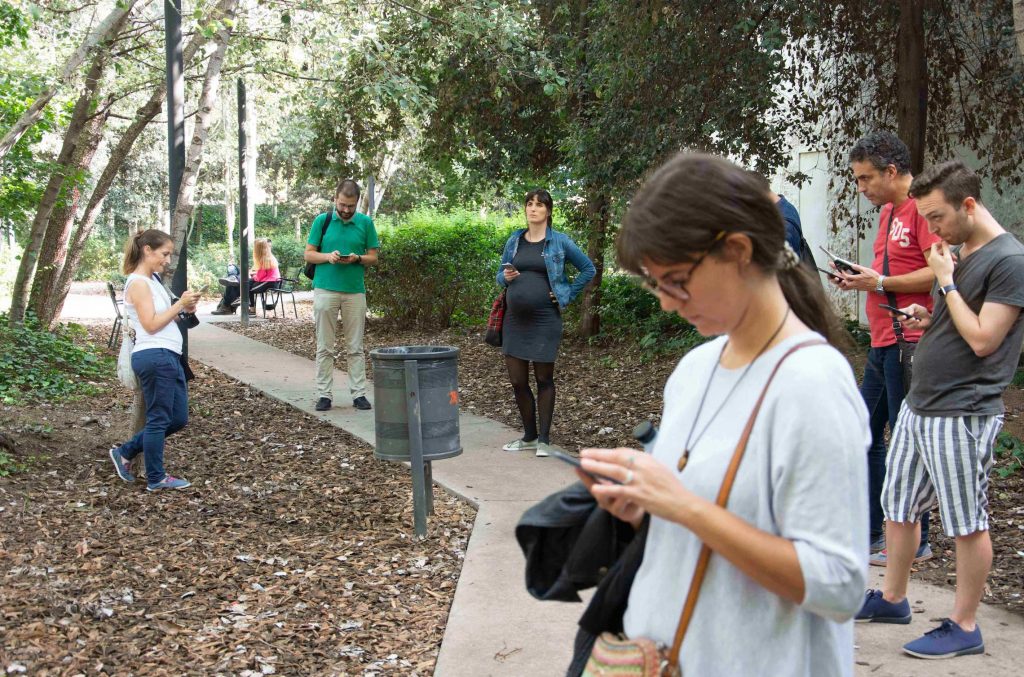Scrollen Sie nach unten, um den Beitrag auf Deutsch zu lesen /// Scroll down for reading the post in German
The December newsletter features in greater detail the Hush City Soundwalk held in Barcelona on September 27th within the Global Program of Hush City Soundwalks for Sound Walk Sunday 2019.
We are grateful to the guest authors: Marc Freixes, Gerard Ginovart-Panisello and Dr. Rosa Maria Alsina-Pagès for their fantastic contribution.
Happy reading!
The Hush City Soundwalk held in Barcelona, Spain, was hosted by the local partner Dr. Rosa Maria Alsina-Pagès (La Salle University) and was led by Dr. Antonella Radicchi (TU Berlin) with a group of 15 local participants in the neighborhood Poblenou.
Hush City Soundwalks were initiated by Dr. Antonella Radicchi in 2017, in parallel to the release of the Hush City app: they are free, public soundwalks guided in search of quietness, in which the Hush City app is exploited to map and evaluate quiet areas in cities [1].
The Hush City app empowers users to identify, access and evaluate everyday quiet areas in their neighborhoods, therefore contributing to their protection and planning by municipalities. Data collected with the Hush City app is linked in real time to the Hush City Map, a web-based map accessible to everyone interested in finding quiet areas near the places they live or in other cities worldwide.
Barcelona strives to be in the lead as a city for which the streets and squares are places of encounter and play, of cultural, economic and social exchange. A city with the cleanest air, plenty of green spaces and peaceful traffic. A city in which people use and enjoy being in public spaces. The program ‘omplim de vida els carrers’ (We fill the streets with life), implements the Supeblocks model in Barcelona (Superilla in Catalan). The project requires everyone’s involvement through a participatory process with neighborhoods and collectives from the areas where the superblock is implemented. They participate in the analysis and design of each Superblock and adapt the model to the characteristics of the area and the specific needs of each case [2]. The aim of the soundwalk in the Superblock Poblenou was to assess whether it could act as a quiet area for Barcelona. Since the superblock model already incorporates participatory planning practices it is an excellent place for inclusionary studies.

Image displaying the map of the Superblock Poblenou, comparing the urban planning street use before and after the implementation of the Superblock project [3].

Image illustrating the soundwalk route held in Barcelona on September 27th. The Poblenou Superblock is marked with a red frame, and the soundwalk’s stops are indicated with numbered markers. This image shows a satellite perspective from Google maps (Map Data: Google 2019)
The soundwalk began on public space within an inner block (Ada Byron Square, see point 1 in Fig. 2), where Dr. Radicchi gave the introduction to the activity. The soundwalk consisted of a guided walk through the superblock Poblenou, with five listening points (see Figure 2). At each location, the participants were invited to first actively listen to the environment for 1-3 minutes in silence, and afterwards assess the location through the Hush City App.
The first listening point was inside the superblock in a green area between the Museum Can Framis and the road (see Figure 3). The second listening point was located between the Museum and the school “Escola flor de maig”. This street has been pedestrianized and the street is currently being used as a public space with plenty of tables, sculptures and a playground. The third listening point was located in an office area next to the Hotel Ibis Barcelona (in Pza Glories 22). In this location minor Tactical Urbanism-orientated interventions were done, consisting of painting the asphalt and installing benches and tables, where office workers usually have lunch. The fourth listening point was in the border of the superblock along a trafficked road and traffic noise dominates the acoustic environment. The soundwalk ended at the fifth listening point, in proximity to one of the access areas of the superblock (point 5 in the map). Here road traffic was also very apparent.

Participants collection ting data and observations at the listening point #1 of the Hush City Soundwalk in Barcelona. Image source courtesy of LaSalle University.
At the end of the soundwalk, a rewarding group discussion took place and the participants shared their impressions of the soundwalks and the soundscapes. The participants were interested by experience, reflecting on how their perspective and senses impacted their opinions of the space. The superblock concept was also discussed. Although the implementation of the superblock seems to have a positive impact on the acoustic environment, there are some neighbours who are opponents to this concept, especially those living along the superblock’s boundaries, where signs against the superblock can be seen appended to balconies. Finally, the importance of public awareness about the quality of the acoustic environment in urban areas was also discussed. Some participants noted that children should be taught about sound and noise at school.
A press release featuring the Hush City Soundwalk was then published by La Salle and it is available here.
Did you enjoy reading this newsletter?
Share with us your comments at info@opensourcesoundscapes.org or on Twitter @HUSHCITYapp.
Quiet regards from Berlin!
The Hush City Mobile Lab Team
[1] Dr. Arch. Antonella Radicchi Soundwalks
[2] Ajuntament de Barcelona, Superilles
[3] Ajuntament de Barcelona, Poble nou Superilles
*CREDITS & ACKNOWLEDGMENTS*
The Global Program of Hush City Soundwalks is initiated and coordinated by Antonella Radicchi in her role of inventor and manager of the Hush City app, and it is part of the Hush City Mobile Lab project, which has received funding from the HEAD-Genuit Foundation.
Hush City app received funding from TU Berlin IPODI-Marie Curie Program (2016-2018) and from the HEAD-Genuit Foundation (2018-2020).
— Deutsch ——————————————————————————————————————————
Im Dezember-Newsletter wird der Hush City Soundwalk, der am 27. September in Barcelona im Rahmen des globalen Programms der Hush City Soundwalks für den Sound Walk am Sonntag 2019 stattfand, ausführlicher beschrieben.
Wir danken den Gastautoren: Marc Freixes, Gerard Ginovart-Panisello und Dr. Rosa Maria Alsina-Pagès für ihren fantastischen Beitrag.
Fröhliches Lesen!
Der Hush City Soundwalk in Barcelona, Spanien, wurde von der lokalen Partnerin Dr. Rosa Maria Alsina-Pagès (Universität La Salle) veranstaltet und von Dr. Antonella Radicchi (TU Berlin) mit einer Gruppe von 15 lokalen Teilnehmern im Stadtteil Poblenou in geleitet Barcelona.
Hush City Soundwalks wurden von Dr. Antonella Radicchi im Jahr 2017 parallel zur Veröffentlichung der Hush City App initiiert: Es handelt sich um kostenlose, öffentliche Soundwalks, die auf der Suche nach Ruhe geführt werden und bei denen die Hush City App genutzt wird, um ruhige Gebiete abzubilden und auszuwerten in Städten [1].
Die Hush City App ermöglicht es den Nutzern, alltägliche Ruhezonen in ihrer Nachbarschaft zu identifizieren, darauf zuzugreifen und zu bewerten, und trägt so zu deren Schutz und Planung durch die Kommunen bei. Die mit der Hush City-App gesammelten Daten werden in Echtzeit mit der Hush City Map verknüpft, einer webbasierten Karte, auf die jeder zugreifen kann, der ruhige Gegenden in der Nähe seiner Wohnorte oder in anderen Städten weltweit finden möchte.
Barcelona strebt nach einer führenden Position als eine Stadt, in der die Straßen und Plätze Orte der Begegnung und des Spiels, des kulturellen, wirtschaftlichen und sozialen Austauschs sind. Eine Stadt mit sauberster Luft, Grünflächen und ruhigem Verkehr. Eine Stadt, in der sich Menschen gerne im öffentlichen Raum nutzen und genießen. Das Programm “omplim de vida els carrers” (Wir füllen die Straßen mit Leben) implementiert das Supeblocks-Modell in Barcelona (Superilla auf Katalanisch). Das Projekt erfordert die Beteiligung aller durch einen partizipativen Prozess mit Nachbarschaften und Kollektiven aus den Bereichen, in denen der Superblock implementiert ist. Sie beteiligen sich an der Analyse und Gestaltung jedes Superblocks und passen das Modell an die Merkmale des Gebiets und die spezifischen Bedürfnisse des jeweiligen Falls an [2]. Das Ziel des Soundwalk im Superblock Poblenou war es, zu beurteilen, ob er als Ruhezone für Barcelona dienen kann. Da das Superblock modell bereits partizipative Planungsmethoden beinhaltet, ist es ein ausgezeichneter Ort für Inklusion Studien.

Abbildung mit der Karte des Superblock Poblenou, in der die städtebauliche Straßennutzung vor und nach der Durchführung des Superblock-Projekts verglichen wird [3].
Daher können die von Superblocks geförderten Flächen nicht nur jetzt, sondern auch bei der Bestimmung zukünftiger Nutzungen für neue Entwicklungen berücksichtigt werden.

Das Bild zeigt die Soundwalk-Route, die am 27. September in Barcelona stattfand. Der Poblenou Superblock ist mit einem roten Rahmen markiert und die Stopps des Soundwalks sind mit nummerierten Markierungen gekennzeichnet. Dieses Bild zeigt eine Satellitenperspektive aus Google Maps (Kartendaten: Google 2019)
Der Soundwalk begann im öffentlichen Raum eines Innenhofes (Ada Byron Square, siehe Punkt 1 in Abb. 2), wo Dr. Radicchi die Einführung in die Aktivität gab. Der Soundwalk bestand aus einem geführten Spaziergang durch den Superblock Poblenou mit fünf Hörpunkten (siehe Abbildung 2). An jedem Ort wurden die Teilnehmer zunächst aufgefordert, sich 1-3 Minuten lang in Ruhe aktiv um die Umgebung zuzuhören und anschließend den Ort über die Hush City App zu bewerten.
Der erste Abhörpunkt befand sich innerhalb des Superblocks in einem grünen Bereich zwischen dem Museum Can Framis und der Straße (siehe Abbildung 3). Der zweite Hörplatz befand sich zwischen dem Museum und der Schule „Escola flor de maig“. Diese Straße wurde Fußgängerzone und der Straßenraum wurde derzeit zum öffentlichen Raum mit vielen Tischen, Skulpturen und einem Spielplatz genutzt.
Der dritte Hörplatz befand sich in einem Bürobereich neben dem Hotel Ibis Barcelona (in Pza Glories 22). An diesem Ort wurden kleinere, auf Taktik und Städtebau ausgerichtete Eingriffe durchgeführt, die darin bestanden, den Asphalt zu streichen und Bänke und Tische zu installieren, auf denen Büroangestellte normalerweise zu Mittag essen. Der vierte Hörpunkt befand sich an der Grenze des Superblocks entlang einer verkehrsreichen Straße und Verkehrslärm dominiert die akustische Umgebung. Der Soundwalk endete am fünften Hörpunkt in der Nähe eines der Zugangsbereiche des Superblocks (Punkt 5 in der Karte). Auch hier war der Straßenverkehr sehr deutlich.
Am Ende des Soundwalks fand eine lohnende Gruppendiskussion statt und die Teilnehmer tauschten ihre Eindrücke auf den Soundwalks und den Soundscapes aus. Die Teilnehmer waren an Erfahrungen interessiert und reflektierten, wie sich ihre Perspektive und ihre Sinne auf ihre Ansichten über den Raum auswirken. Das Superblock-Konzept wurde ebenfalls diskutiert. Obwohl die Implementierung des Superblocks einen positiven Einfluss auf die akustische Umgebung zu haben scheint, gibt es einige Nachbarn, die sich diesem Konzept widersetzen, insbesondere diejenigen, die entlang der Grenzen des Superblocks leben und an Balkonen Zeichen gegen den Superblock erkennen lassen. Schließlich wurde auch die Bedeutung des öffentlichen Bewusstseins für die Qualität der akustischen Umgebung in städtischen Gebieten erörtert. Einige Teilnehmer wiesen darauf hin, dass Kinder in der Schule über Geräusche und Lärm unterrichtet werden sollten.
Eine Pressemitteilung mit dem Hush City Soundwalk wurde dann von La Salle veröffentlicht:
https://www.salleurl.edu/ca/hush-city-soundwalk-barcelona-ciutadans-que-mesuren-el-soroll-la-superilla-del-poblenou-amb-una-app
Hat es Ihnen Spaß gemacht, diesen Newsletter zu lesen?
Teilen Sie uns Ihre Kommentare unter info@opensourcesoundscapes.org oder auf Twitter unter @HUSHCITYapp mit.
Ruhige Grüße aus Berlin,
The Hush City Mobile Lab Team
[1] Dr. Arch. Antonella Radicchi Soundwalks
[2] Ajuntament de Barcelona, Superilles
[3] Ajuntament de Barcelona, Poble nou Superilles
*CREDITS & DANKSAGUNG*
Das globale Programm 2019 von Hush City Soundwalks wird von Antonella Radicchi als Erfinderin und Managerin der Hush City-App initiiert und koordiniert und ist Teil des Hush City Mobile Lab Projekts (2018-2020), das von der HEAD-Genuit Stiftung finanziert wurde.
Die Hush City App wurde vom IPODI-Marie-Curie-Programm der TU Berlin (2016-2018) und von der HEAD-Genuit Stiftung (2018-2020) gefördert.